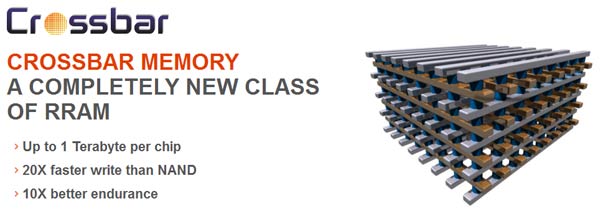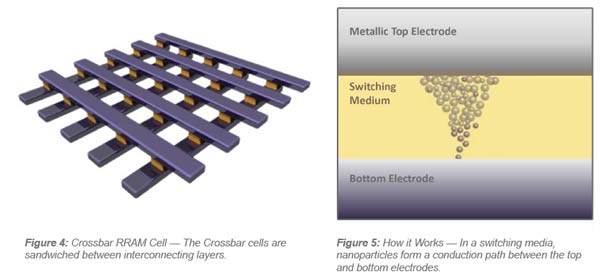A Californian tech startup going by the name of Crossbar has announced a new kind of memory chip which can store 1TB of data in a space as small as a postage stamp. In addition to its smaller size these new resistive memory chips offer "20X faster write than NAND" and "10X better endurance". The company says its resistive RAM (RRAM) technology is disruptive in that it will upset the apple cart that is the $60 billion flash memory market and at the same time enable many new possibilities in electronic devices, especially portable ones.

The company revealed its new RRAM yesterday saying it was now ready for prime time. In a press release entitled 'Crossbar emerges from stealth-mode' the company asserted that it has manufactured working memory arrays, validating the simplicity and manufacturability of Crossbar Resistive RAM.
The main bullet points highlighting the qualities of this disruptive technology are as follows:
- Highest Capacity: Up to 1 Terabyte (TB) of Storage on a Single Chip; Multiple Terabytes with 3D Stacking
- Lowest Power: Extends Battery Life to Weeks, Months or Years
- Highest Performance: 20x Faster Write than NAND
- Easiest SOC Integration: Simple Stacking on Logic in Standard CMOS at Most Advanced Nodes
- Most Reliable: 10x the Endurance of NAND; Approaching DRAM Reliability
If you had a wish list for a NAND RAM replacement you might well write down a lot of the points above. The capacities, power saving and reliability claims are music to the ears of computer enthusiasts, especially people who like their portable electronics. Above and beyond these qualities the commercial readiness of the product means it's not just another interesting research study project. Crossbar states it has "developed a working Crossbar memory array at a commercial fab, a major milestone in the development of new memory technology, signalling its readiness to begin the first phase of productization".
Advantages of RRAM over NAND - click to zoom in
Crossbar says that its new RRAM memory cell is based upon "three simple layers" which consist of "a non-metallic bottom electrode, an amorphous silicon switching medium and a metallic top electrode". The memory stores information by changing resistance rather than storing electrical charge, a process that requires less energy and can store more information at a higher density, also there is less electrical stress on the material components so RRAM memory should offer greater endurance and reliability.

Talking about the new RRAM George Minassian, chief executive officer, Crossbar, Inc. said "...today’s non-volatile memory technologies are running out of steam, hitting significant barriers as they scale to smaller manufacturing processes. With our working Crossbar array, we have achieved all the major technical milestones that prove our RRAM technology is easy to manufacture and ready for commercialization. It’s a watershed moment for the non-volatile memory industry." Indeed with its performance and reliability, very high capacity and low power consumption this RRAM could be incredibly popular and game changing.
Future applications and uses of Crossbar RRAM are foreseen to be; consumer electronics, mobile phones and tablets, enterprise storage, SSDs and cloud computing, 'The Internet of Things', secure payments and that other hot new tech - wearable computing. Crossbar has plans to license its technology to SoC developers.














